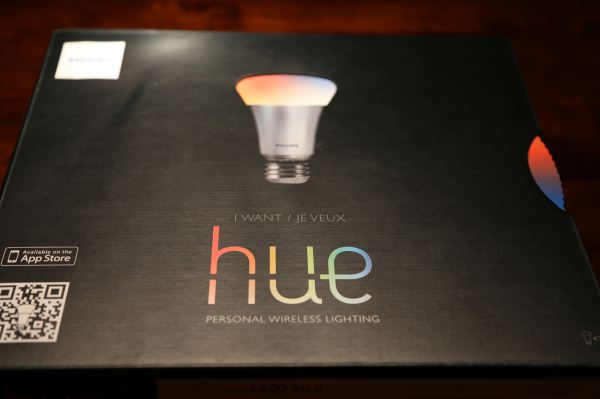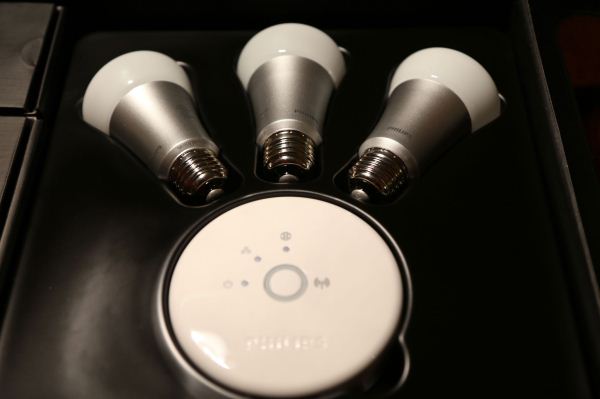Philips Hue: Automated Home Lighting Gets Colorful
by Ashu Joshi on March 1, 2013 12:50 AM EST- Posted in
- Gadgets
- Home Automation
- Philips
- Hue
- Lighting
Introducing the Philips Hue
Before we get started, we’d like to introduce Ashu Joshi to our readers. He has a background in networking and has used a variety of home automation devices over the years. As such, he brings a useful perspective to our staff and can help augment our review coverage. Note also that as with all of our articles, these pieces reflect the opinions of the writer(s) and are not in any way associated with or influenced by any other source (e.g. other employers).
Philips sent out a review sample of their new Hue lighting system, a set of three Hue lights with the Hue Bridge that allows you to remotely control the lights. Besides being able to turn the lights on or off, the big claim to fame of the Hue is that you can set the lights to a variety of colors, or you can even program them to cycle through colors. Home automation systems are often proprietary and can be quite expensive, so the entry of Philips into this market (albeit in a limited fashion) with their Hue lighting system has the potential to shake things up a bit.
The lights have colored LEDs, and while the initial pack only includes three Connected Bulbs (referred to informally as "bulb" or "light" throughout the remainder of this review), you can potentially add up to 50 lights throughout your house/property. One thing that hasn’t changed yet however is that pricing is quite high: the initial Starter Pack will set you back $200. But how does the Philips Hue work in practice, and could it be worth the cost of entry? Note that at present, the Philips Hue is only appears to be sold through the Apple Store as an “App-Enabled Accessory”, but Android is also supported. Long-term we will likely see support for other operating systems as well, but for now this is primarily an iOS/Android targeted device.
Packaging and Contents
One thing that immediately stands out with the Philips Hue is the packaging. It’s very well designed and eye-catching, and I love that you’re able to get a preview of the lighting options with the dial on the box. I set up my Philips Hue controller and bulbs recently, and my initial impressions have been very positive. It’s very easy to install and the experience of this lighting system is quite the change from your everyday lights. I uploaded a few videos of the package in action so you can see what it looks like.
Included in the package are three Connected Bulbs, and they’re quite a bit heavier than a typical light bulb. Most likely the added weight comes from the controller and antenna necessary to talk to the network, and possibly the addition of multi-colored LEDs adds a bit as well. Whatever the reason for the added weight, at least the heft makes you feel like you’re getting a bit extra for the $60 per light.
The other major item included with the Starter Pack is the Hue Bridge. This is a small, circular, lightweight controller with three LEDs on the top and a large circular button in the center used for the pairing function—Philips refers to it as the “link” button. On the side is an Ethernet port to connect to the home network and a power receptacle. The three LEDs show the status of Power, Ethernet, and Internet connections. There is no lettering to indicate what the LEDs are for but they use fairly common icons to indicate the function.
You also get a power adapter with a reasonably long cable for the Hue Bridge, though this is somewhat subjective. I have seen plenty of products where to save pennies they have short cables that ruin the setup experience and force the use of an extension cord, but for most users the Hue adapter should prove sufficiently long. An Ethernet cable is also provided to connect the Hue Bridge to your network, so plan ahead and realize that the Hue Bridge will need both power and network wires and place it accordingly.


















94 Comments
View All Comments
nathanddrews - Friday, March 1, 2013 - link
The difference being, of course, that LIFX uses a master 802.11n bulb to control all the 802.15.4 slave bulbs instead of an extra controller box plugged in elsewhere. Also, unlike the Philips system, you have to not just have the app but also must be on the network in order to control the bulbs as each of the LIFX slave bulbs will only work with the master bulb which is behind your network password. The Philips system has no such security, which immediately removes it from the running, IMO.xdpfddai - Friday, March 1, 2013 - link
This is incorrect. The Phillips controller hub is behind your wireless network, so whatever security you have on that applies. They are both secure. 802.15.4 also applies to ZigBee.nathanddrews - Friday, March 1, 2013 - link
The controller hub/bulb isn't in question, it's the slave bulbs that I'm concerned about. The article probably needs to flesh out this comment better:"Given the use of the ZigBee controller along with the fact that there is no configuration on a per device level to connect it to the network (e.g. you just buy additional bulbs and they apparently broadcast and communicate with any and all Hue devices), we would assume that 50 lights and a single Bridge is about as far as you'll be able to go within a single area. Conceivably, there could also be problems if your immediate neighbor also picked up a Hue—how would the lights know to talk to your Hue network and not his? This is both the blessing and curse of going with an easy to configure technology."
If your neighbor can buy a Hue Hub and just start controlling your bulbs, then it is certainly NOT secure. LIFX appears to have locked out this capability simply by using the built in 802.15.4 encryption, so perhaps this is a case of LIFX applying the encryption and Philip not.
"We have considered security. The WiFi connection will use the standard security set-up that you are currently using. Mesh networks based on 802.15.4 will encrypt packets using AES-128. Higher network stack layers will need to handle exchange of security keys and deal with problems like "replay attacks". In short, your lights will be as secure as your home wifi network."
xdpfddai - Friday, March 1, 2013 - link
Just RTFM on ZigBee and 802.15.4. In short, they both use 128bit crypto. You don't have to worry about it as the end user either. If anyone is going to do their due diligence, it's going to be Phillips. You need to realize that both LIFX and the Phillips implementation are 802.15.4.This Guy - Saturday, March 2, 2013 - link
Last time I checked zigbee uses a four digit, numerical key to identify mesh networks. Not exactly secure.iamezza - Sunday, March 3, 2013 - link
So someone could hack into your light system and screw with your lights? Not really a big deal TBH.SodaAnt - Friday, March 1, 2013 - link
I think that the technology is almost there, but the price isn't. For this to be a reality for normal users, each bulb would need to be in the $10-$20 range, and would only really gain widespread acceptance if each bulb was below $10. To me, these really only make sense if you have a small apartment or something and can easily light it with 3-5 bulbs total, and even then its a significant expenditure.This Guy - Saturday, March 2, 2013 - link
The zigbee radio's and high output RGB LED's are a significant additional cost (compared to the $10 RGB IR controlled globes you can but for $5 - $10). Neither item is mass produced on the scale that truely reduces their price.Ualdayan - Tuesday, March 5, 2013 - link
There are cheaper Zigbee bulbs. I saw on another site somebody mentioned Limitless LED that are only $57 for 2 bulbs+wireless bridge for phone/tablet, and $19 per additional bulb. Now - they only offer a 3 year warranty (Hue is 5 years I believe), and from what I've read their software isn't as 'fun' as Hue's. Eg nothing like Hue's ability to set a 'beach' mode, 'reading' mode, or 'sunset' mode. Let's face it - nobody needs these - they're just for fun. With that in mind I think personally even at double the price I'd go for the ones that have software that is more 'fun'.I just have too many other things I know I should replace before having fun with lightbulbs.
Rick83 - Friday, March 1, 2013 - link
Except, not really, because at that price it's going to have an exclusive audience.Something that I did't quickly find in the review is the quality of the actual bulbs. (Considering that this is the business end of the product, I should be able to?)
The controller itself certainly is interesting, but then it's "merely" Zigbee in a box.
A comparison to similarly specced non-smart LED lights would have given a better price differential for the smartness.
Also, I can't really come up with a use case. For me, the light in a room is always tailored to the room. The only reason to use this kind of semi-smart light, is if you have limited rooms, and need to multipurpose them, by varying the lighting. Then of course, you don't need nearly 50 lights.
To me this looks like the answer to a question nobody asked.